Maris Piper potatoes stand out as a popular choice for their exceptional taste, texture, and cooking properties. Whether you’re baking, roasting, frying, mashing, or boiling, these vegetables have been a go-to option for many chefs and home cooks alike.
Let’s explore the origin and features of Maris potatoes when to plant them, and their nine excellent substitutes. Get ready to broaden your potato horizons!
Contents
What Are Maris Piper Potatoes?
Maris Piper potatoes are a popular and well-known variety of potatoes originating from Scotland.
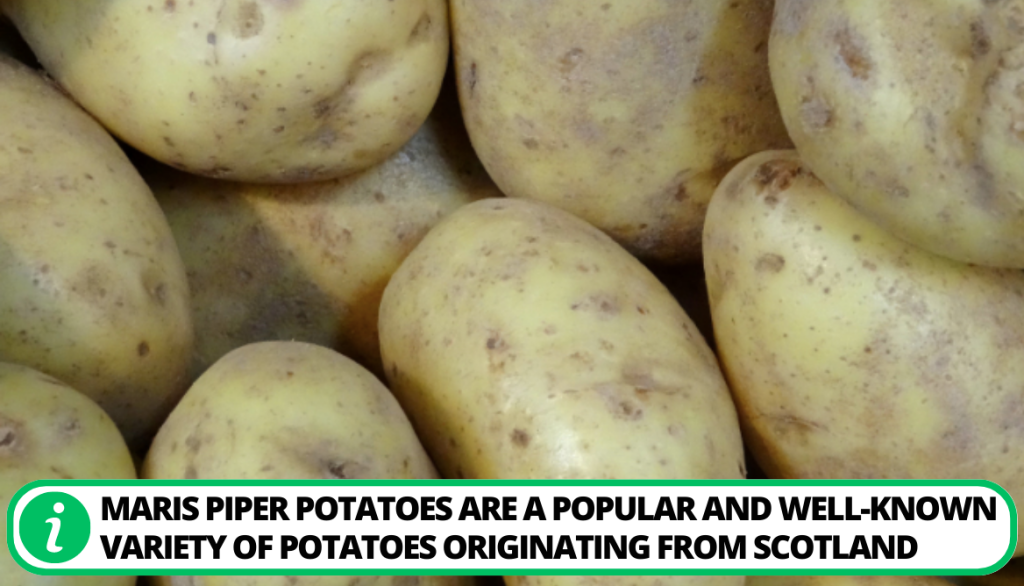
- They were first bred in 1966 by a plant breeder named Donald Mackenzie at the Scottish Plant Breeding Station.
- This potato was the result of a cross between the “Crosby potato ” and “Mayan Gold potato.”
- Maris Piper potatoes were specifically developed to meet the needs of the British culinary market.
The Pros And Cons Of The Maris Piper Potato Variety
Maris Piper potatoes like any other varieties have both positive and negative aspects. Let’s take a look at some of them.
- High-yielding potato variety
- Versatility in cooking such as roasting, baking, boiling, etc
- Great taste and creamy texture
- Good storage properties
- High dry matter content
- Resistant to some diseases
- Requires careful consideration of the growing environment.
- Limited availability
- Maris Tubers has uniformity issues in size and shape
- Susceptible to specific diseases
Features Of Maris Potato Varieties
Maris Piper potato varieties possess a combination of qualities that make them an all-rounder option in the potato landscape.
In this section, we will discuss these features in greater detail, so you can gain a comprehensive understanding of what sets Maris Piper potatoes apart and makes them an enduring favorite in kitchens everywhere.
1. Yield Potential and Dry Matter Content
Maris Piper potatoes are known for their impressive yield potential, making them an efficient choice for commercial cultivation.
Additionally, Maris Piper potato exhibits a desirable dry matter content. This means they have a lower water content and a higher starch content, contributing to their excellent cooking qualities.
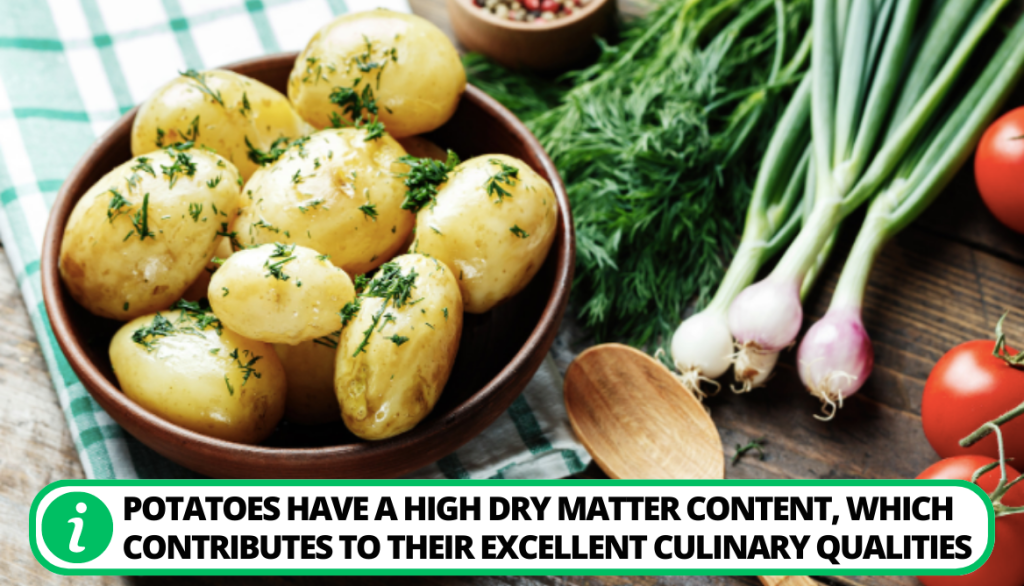
2. Culinary Excellence
The Maris Piper potato excels in the kitchen, making it a top choice for cooks and chefs worldwide.
- Its creamy texture and rich, earthy flavor lend themselves well to a variety of culinary preparations.
- Whether mashed, boiled, baked, roasted, or fried, Maris Piper potatoes maintain their shape, texture, and taste.
- This feature makes them an all-rounder for numerous recipes, from fluffy mashed potatoes to crispy golden skin chips or french fries.
3. Potato Appearance
Maris Piper potatoes have a distinctive appearance:
- They are medium to large-sized potatoes with an oval or slightly oblong shape.
- The skin of Maris Piper potatoes is known for their golden skin and creamy-white flesh, often with patches of pink or purple.
- These characteristics contribute to the potato’s visual appeal, making it an attractive choice for all-rounder recipes and presentations.
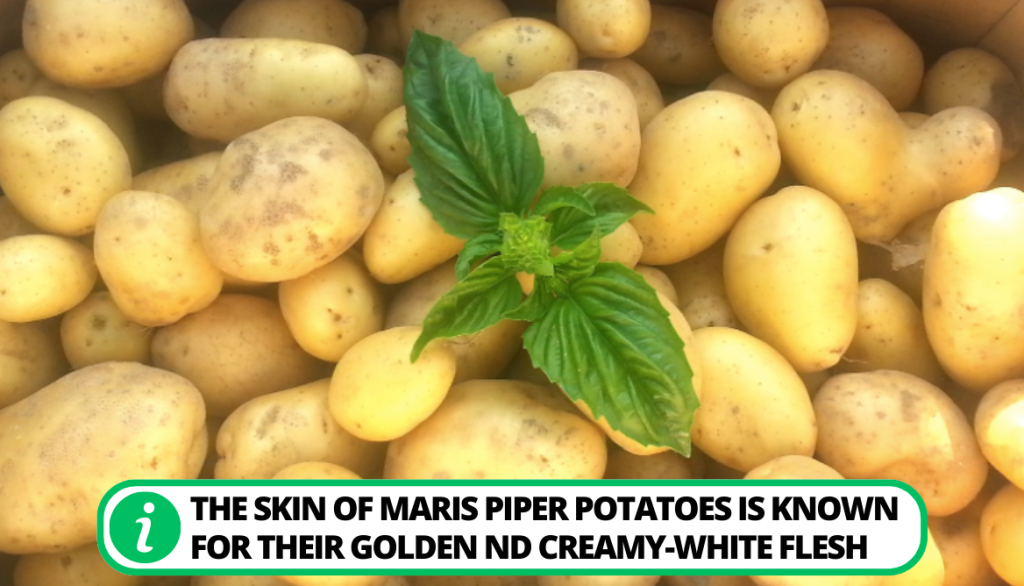
4. Maris Piper Plant Characteristics
The Maris Piper potato plant exhibits vigorous growth, with strong and sturdy stems:
- The potato plants have good foliage cover, which aids in efficient photosynthesis and supports the development of numerous tubers.
- This robust growth contributes to the high yield potential of the Maris Piper potato variety.
5. Resistance To Diseases
Maris Piper potato displays moderate resistance to some common potato diseases, including:
- Late blight (Phytophthora infestans);
- Common scab (Streptomyces scabies).
However, like all potato varieties, they are not entirely immune to diseases and may require appropriate disease management practices to minimize potential damage.
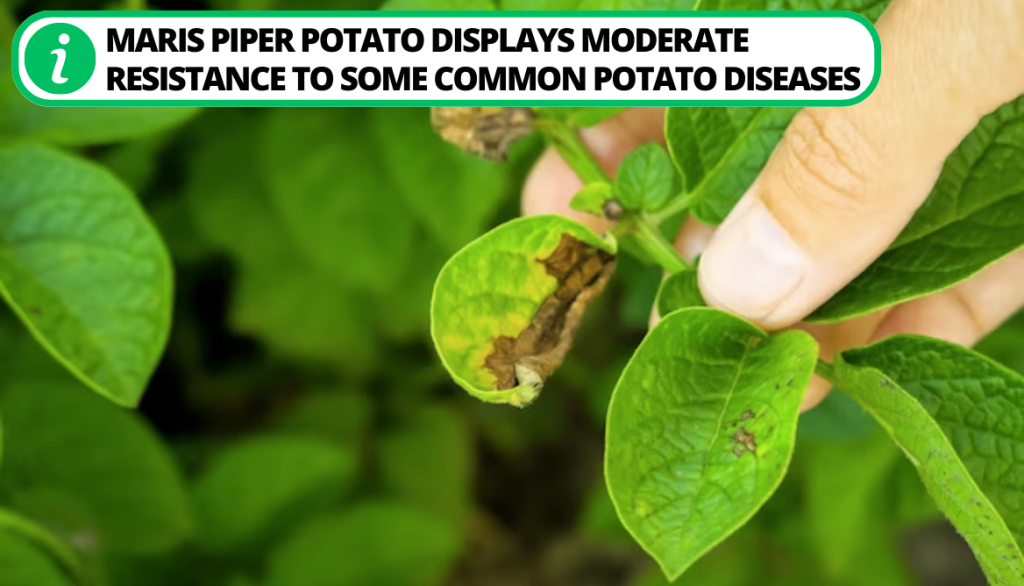
6. Resistance to Pests
Although Maris Piper potatoes can be somewhat resistant to some pests, such as the Colorado potato beetle (Leptinotarsa decemlineata), they can still be vulnerable to others, such as the potato cyst nematode (Globodera pallida).
7. Resistance to Damage
Maris Piper potato has a relatively thick skin, which provides some protection against physical damage during harvesting, handling, and storage.
However, proper handling and storage practices are essential to prevent bruising and other damage that can affect the quality of potato tubers.
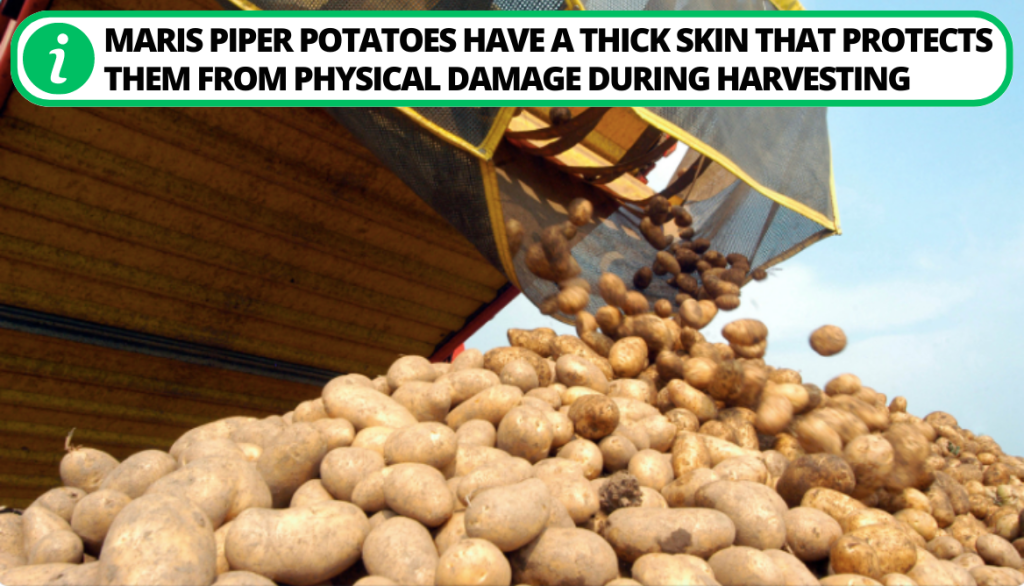
8. Storage Qualities
Maris Piper potatoes have good storage qualities. When properly stored in cool, dark, and well-ventilated conditions, they can be stored for several months without significant loss of quality.
Table For Maris Piper Potato Characteristics
Let’s discover a brief description of Maris Piper’s key attributes, from its origins and scientific name to its texture, flavor, and preferred culinary applications.
Characteristic | Description |
Name: | Maris Piper, Maris Peer potato |
Origin: | Scotland |
Scientific name: | Solanum tuberosum |
Breeder: | Donald Mackenzie |
Plant Breeding Institute: | Maris PiperAgricultural Experimental Station in Cambridge |
Shape: | Smooth |
Flesh Color: | Creamy white-colored skin with light brown patches |
Texture: | Smooth and floury texture |
Flavor: | Balanced and mild |
Culinary Uses: | Chips, baking, mashing, roasting, and boiling |
Yield: | High-yielding variety |
Size: | Medium-sized weigh 2 to 3.5 ounces while large-sized weigh 3.5 to 5.5 ounces each |
Regional Planting Time for Maris Piper Potatoes
Maris Piper potatoes are typically planted in early spring and they are typically harvested during peak season in late summer or early fall. Maris Piper potatoes prefer soil temperatures around 7-10°C (45-50°F) for optimal growth and should be planted when the soil has reached this temperature range.
The exact timing for planting Maris Piper potatoes can vary based on your specific location and local climate conditions. Here are some guidelines for different regions, including the United States:
1. United Kingdom and Ireland
Maris Piper potatoes are commonly planted in the UK and Ireland between late March and mid-April, once the risk of frost has passed.
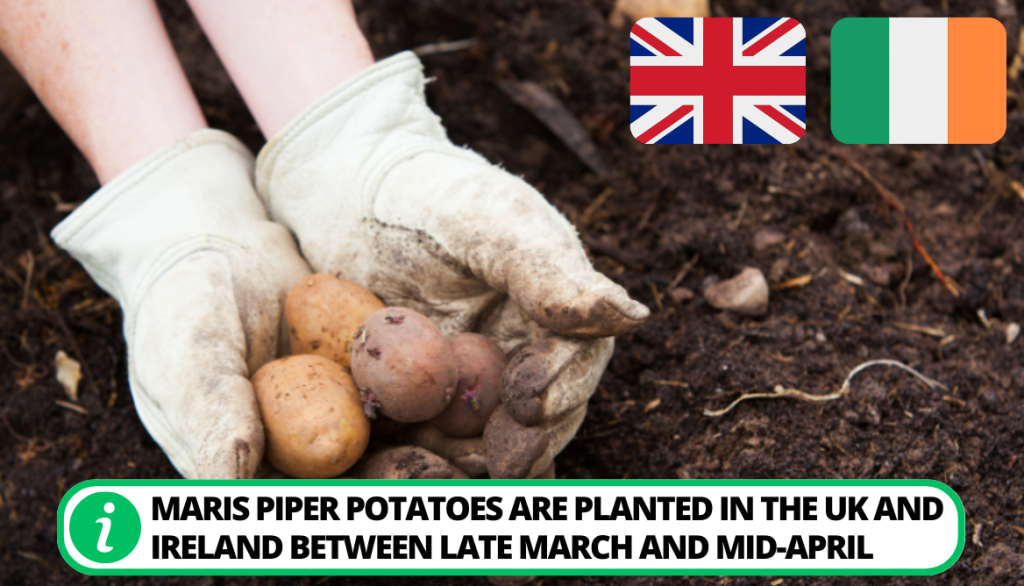
2. United States
The state is one of the largest producers of potatoes globally and is cultivated in various states throughout the nation. Here’s a brief overview of when to cultivate potatoes in the United States:
- Northeast (e.g., New York, Massachusetts, Pennsylvania): Maris Piper potatoes are grown in late spring or early summer, after the last frost date, which can vary from April to June.
- Midwest (e.g., Illinois, Ohio, Indiana): Similar to the Northeast, late spring or early summer planting is recommended after the last frost date.
- South (e.g., Texas, Florida, Georgia): In the southern states with milder winters, you can cultivate Maris Piper potatoes earlier, possibly as early as late winter or early spring, depending on local climate and soil conditions.
- West Coast (e.g., California, Oregon, Washington): Grow Maris Piper potatoes in late winter or early spring in coastal regions with milder winters.
- Northwest (e.g., Idaho, Montana, Wyoming): In northern states with colder climates, you can cultivate Maris Piper potatoes in late spring after the last frost date.
3. Canada
Potatoes are an essential crop in Canada, and the country ranks among the top potato producers in the world supporting both its domestic market and export industry. Here’s an overview of potato growing in Canada:
- Maritimes (e.g., Nova Scotia, New Brunswick, Prince Edward Island): You can sow Maris seed potatoes in late spring or early summer after the last frost date, which is usually in May or June.
- Quebec and Ontario: Similar to the Maritimes, late spring planting is recommended after the last frost date.
- Prairie provinces (e.g., Manitoba, Saskatchewan, Alberta): Sow Maris Piper potatoes in late spring or early summer after the last frost date, which can vary from May to June.
- British Columbia: In coastal regions, raise Maris Piper in late winter or early spring. In interior regions, you will have to grow Maris potato varieties in late spring after the last frost date.
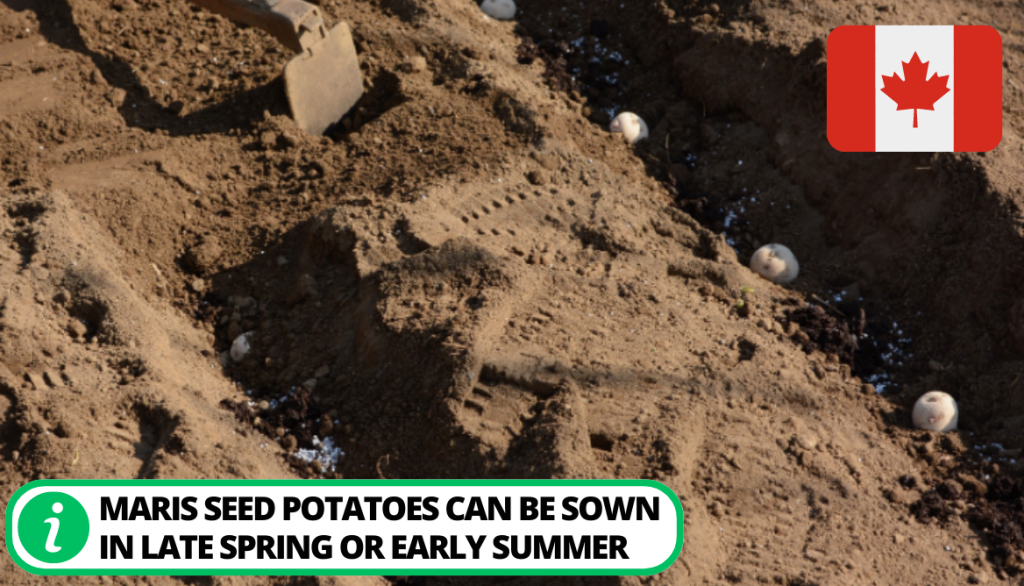
4. Australia
In Australia, Maris Piper potatoes are also grown and enjoyed by many. Here’s some information about Maris Piper potatoes and their cultivation;
- Maris Piper potatoes are typically planted in late winter or early spring, depending on the specific region.
- In southern regions, planting may occur from August to October, while in northern regions, it may happen from April to July.
Tips For Buying Maris Piper Potatoes
When purchasing Maris Piper potatoes, consider the following advice to ensure you get the best quality;
- Freshness: Look for fresh potatoes with smooth skin and no signs of sprouting decay, or green patches. Freshness is crucial for getting the best taste and texture.
- Firmness: Gently squeeze the potatoes to check for firmness. Avoid those with soft spots or spongy areas, as they may be old or have started to spoil.
- Size: Maris Piper potatoes come in different sizes, but it’s generally best to choose potatoes that are medium size, as they tend to have a good balance of starch and moisture.
- Skin Color: The skin of Maris Piper potatoes should be light brown or pale yellow. Avoid potatoes with greenish hues, as this may indicate exposure to sunlight and the presence of solanine, which can be toxic in large amounts.
- Storage: Check the storage conditions at the store to ensure the potatoes are kept in a cool, dry, and dark place. Proper storage helps maintain their freshness and prevents sprouting.
- Organic or Conventional: Decide whether you prefer organic or conventionally grown potatoes. Organic potatoes are free from synthetic pesticides and fertilizers, but they might be more expensive.
- Local Produce: Whenever possible, try to buy locally grown Piper potatoes. Locally sourced produce is often fresher and supports the local economy.
- Quantity: Buy the amount you need for immediate use or short-term storage. Potatoes are perishable and can start to deteriorate over time.
- Seasonality: Pay attention to the seasonality of Maris Piper potatoes. While they are available year-round, they are typically harvested from late summer through early spring. Buying potatoes in their peak season ensures better flavor and quality.
- Avoid Pre-bagged Potatoes: If possible, buy loose Maris potatoes rather than pre-bagged ones. This way, you can inspect each potato individually and choose the best ones.
- Certified seed potatoes: Look for certified seed potatoes to ensure better quality and reduce the risk of disease transmission to your garden.
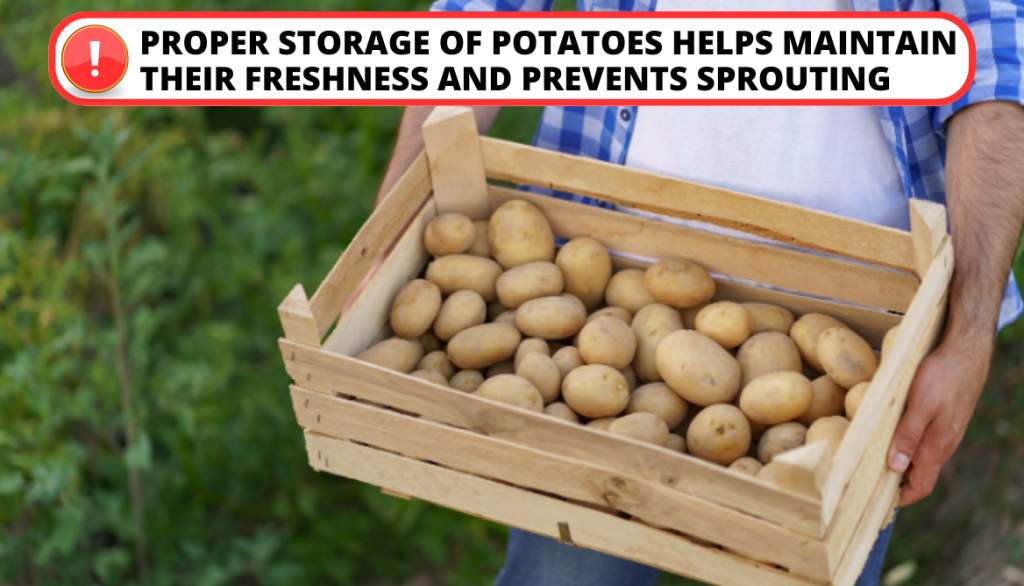
9 Top Substitutes for Maris Piper Potatoes
When it comes to potatoes, the beloved Maris Piper variety holds a special place in many hearts due to its versatility and excellent texture. However, if you find yourself unable to get the Maris Piper variety for your culinary creations, fear not!
There are several top-notch alternatives that can step up to the plate and deliver similar results. Let’s explore some fantastic substitutes that can seamlessly replace Maris Piper potatoes in various recipes, ensuring your dishes remain flavorful and satisfying.
1. Russet Potatoes
One of the most popular substitutes for Maris Piper potatoes is the reliable Russet potato.
- With its high starch content and light, fluffy nature, Russet potatoes are perfect for baking, frying, mashing, and making deliciously crispy chips.
- Their neutral flavor profile allows them to absorb other ingredients well, making them a go-to option in a wide range of savory side dishes.
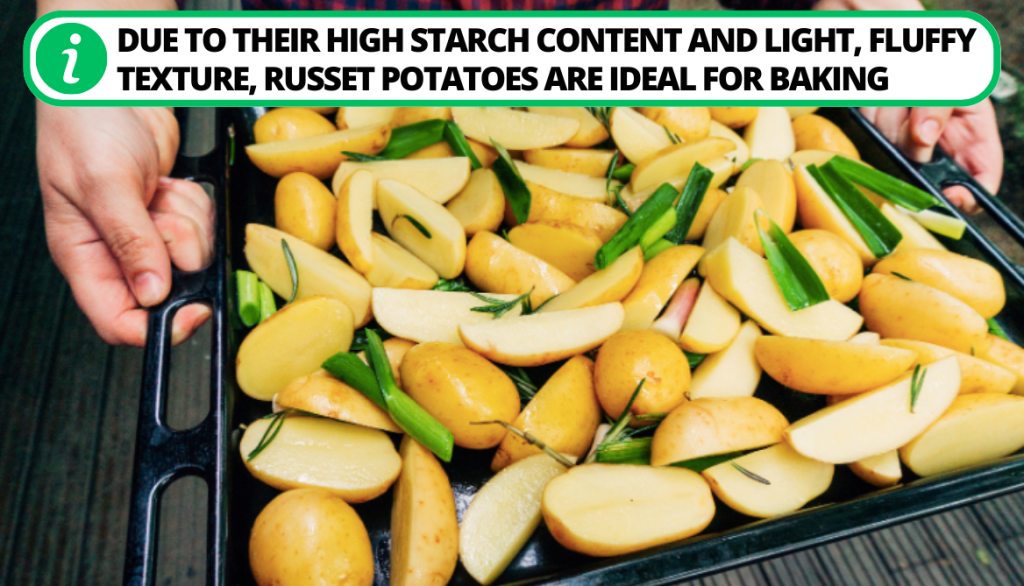
2. Inca Bella Potatoes
For a creamier and smoother alternative to Maris Piper potatoes, Inca Bella potatoes fit the bill:
- These small, waxy potatoes have a natural buttery taste and hold their shape remarkably well when cooked.
- They are an excellent choice for boiling, roast potatoes, or using in salads, adding a delightful texture and flavor to your recipes.
3. Yukon Gold Potatoes
With their golden-yellow flesh and thin skin, Yukon Gold potatoes offer a smooth, buttery taste that is comparable to Maris Pipers:
- Their medium starch content strikes a balance between waxy and starchy, making them suitable for a wide array of culinary use, including baking, boiling, and chips.
- Whether it’s creamy mashed potatoes or crispy roasted wedges, Yukon Golds won’t disappoint you.
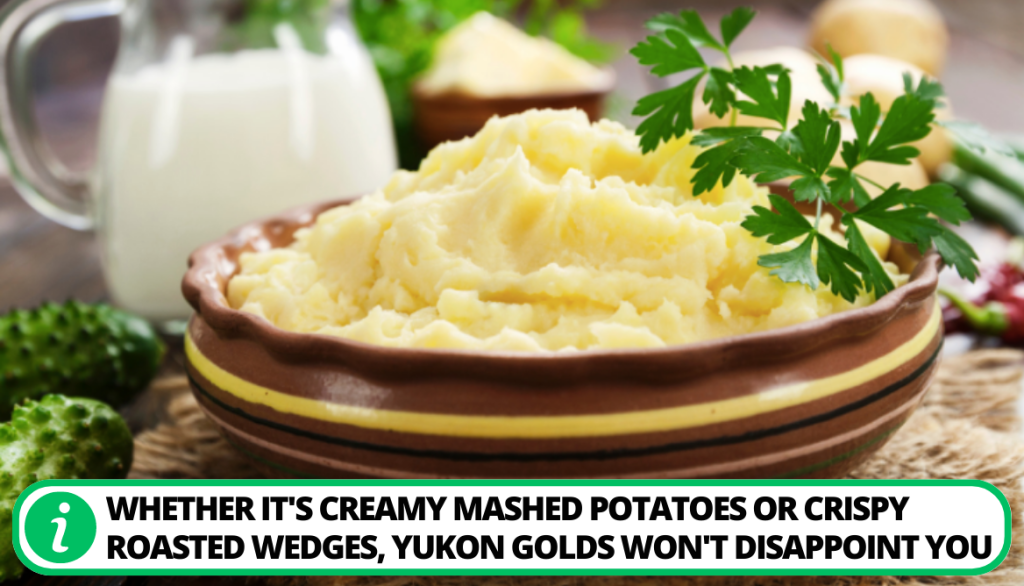
4. Red Potatoes
Another noteworthy substitute for Maris Piper is the vibrant and waxy Red potatoes:
- With a slightly sweet flavor and smooth texture, red potatoes hold their shape well when cooked.
- Red potatoes are particularly excellent for boiling, steaming, and using in salads, adding a pop of color to your dishes.
5. Sweet Potatoes
For a unique twist on traditional potato recipes, sweet potatoes can be a delightful alternative to Maris Pipers:
- Sweet potatoes offer a naturally sweet and earthy flavor, along with a creamy texture when cooked.
- They are excellent for mashing, baking, or making sweet potato fries, adding a nutritious touch to your meals.

6. Kennebec Potatoes
Kennebec potatoes share similarities with Maris Piper’s, offering a light and fluffy texture with medium starch content.
- They are great for frying, baking, and making mashed potatoes.
- Their versatility makes them an excellent substitute for many recipes, showcasing a deliciously satisfying taste.
7. Fingerling Potatoes
If you’re looking for an elegant alternative, fingerling potatoes might be the perfect choice:
- These small, elongated potatoes come in various colors and boast a nutty flavor and a firm, waxy texture.
- Fingerlings are good for roasting, boiling, or in vegetables and salads for a visually appealing and tasty addition to your meals.

8. King Edward Potatoes
For a classic British alternative to Maris Pipers, King Edward potatoes are an excellent option.
- These potatoes have a moderate starch content, falling between waxy and floury varieties. This balance allows them to hold their shape somewhat when boiled, while still providing a fluffy texture when mashed
- They work well in various recipes like roasts, mashed potatoes, and gratins, providing that comforting and familiar taste.
9. Purple Potatoes
Purple potatoes have a unique and cool appearance due to their vibrant color, which can add a fun and eye-catching element to your recipe.
- These vibrant tubers have a medium starch content and hold their shape when cooked.
- You can use purple potato in salads recipe, mashed dishes, or as roasted wedges for an exciting twist on a traditional potato side dish.

FAQ
What kind of potato is a Maris Piper?
Maris Piper is a type of potato cultivar that is commonly grown in the United Kingdom and Ireland. It is a maincrop potato variety, meaning it takes a longer time to mature compared to early potato varieties.
What can Maris Piper potatoes be used for?
Maris Piper potatoes are widely used for various culinary purposes. Due to their high starch content and fluffy texture when cooked, they are particularly well-suited for making crispy roast potatoes, chips or French fries, and mashed potatoes.
Is Maris Piper a waxy potato?
No, Maris Piper potatoes are not considered waxy potatoes. Waxy potatoes have a low starch content and hold their shape well when cooked, making them suitable for dishes like potato salads and stews.
Why are they called Maris Piper?
The name “Maris Piper” is derived from the Maris Piper Agricultural Experimental Station, Maris Lane in Trumpington, Cambridgeshire, United Kingdom.
This plant breeding institute headed by Dr. Harold Howard developed the Maris Piper potato in the mid-20th century and released it for commercial production in 1966.
Conclusion
Maris Piper potatoes are highly regarded for their exceptional taste, texture, and cooking properties. They are a favorite choice for chefs and home cooks due to their versatility in various culinary preparations.
In a number of dishes, Maris Piper can be swapped out for other potato varieties with distinctive qualities and flavors, which includes russet potatoes, Inca Bella potatoes, Yukon Gold potatoes, red potatoes, and sweet potatoes, among others.
What is your favorite substitute for Maris Piper potatoes and why? Let’s know your choice in the comment section. Thanks for reading.
- How to Get Potatoes to Sprout Eyes: Detailed Growing Guide with 3 Options - July 31, 2023
- Weight of a Medium Potato: Revealed in Detailed Guide - July 29, 2023
- Maris Piper Potatoes: 9 Substitutes You Should Know About - July 27, 2023
Hello! I’m Jessica Zander, a garden coach and consultant based in the Boston area (zone 6b), offering virtual consultations across the country and Canada.
I’ve been passionate about gardening since the early 1990s, and in 2022, I launched You Can Do It Gardening to empower individuals to feel more confident in their gardening endeavors.
Following a 30-year career in nonprofit finance and operations, I transitioned out of that field in mid-June of 2023 due to the growing demand for coaching services. Interestingly, my years of presenting financial statements to boards and finance committees proved to be valuable experience for teaching people about gardening! I enjoy sharing skills, providing guidance and suggestions, and collaborating efficiently with clients to make significant improvements to their outdoor spaces, both small and large. I also regularly teach at the Arlington Continuing Education and Cambridge Adult Education.
My approach is direct and practical, akin to Mary Poppins, but tailored to your garden. Clients find satisfaction in saving money and taking pride in their own gardening achievements.

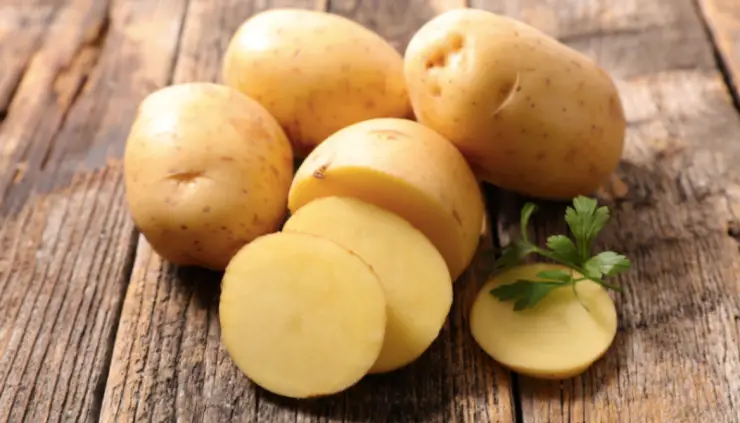
Add comment